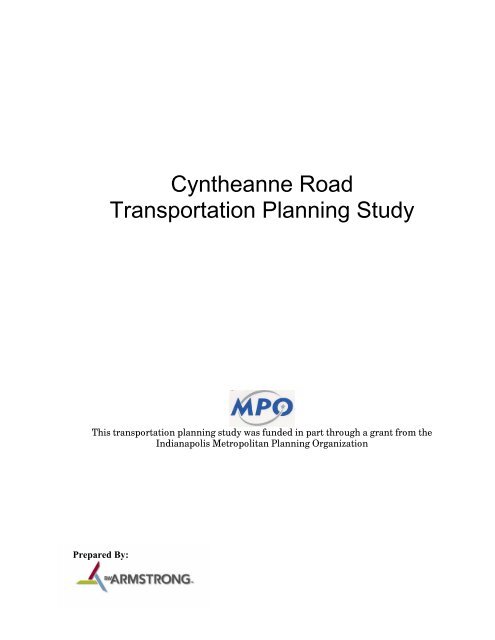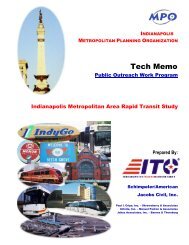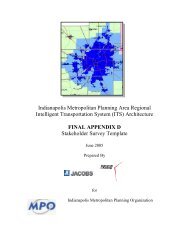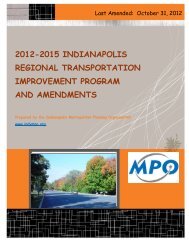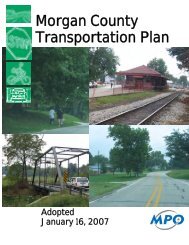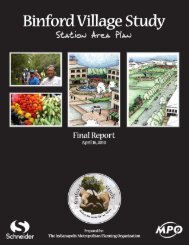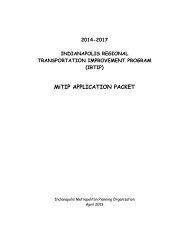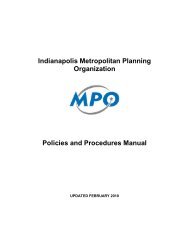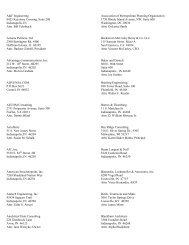Cyntheanne Road Transportation Planning Study - Indianapolis ...
Cyntheanne Road Transportation Planning Study - Indianapolis ...
Cyntheanne Road Transportation Planning Study - Indianapolis ...
Create successful ePaper yourself
Turn your PDF publications into a flip-book with our unique Google optimized e-Paper software.
<strong>Cyntheanne</strong> <strong>Road</strong><br />
<strong>Transportation</strong> <strong>Planning</strong> <strong>Study</strong><br />
This transportation planning study was funded in part through a grant from the<br />
<strong>Indianapolis</strong> Metropolitan <strong>Planning</strong> Organization<br />
Prepared By:
Contents<br />
Executive Summary<br />
1.0 Project History<br />
1.1 Project Description<br />
1.2 Limits of <strong>Study</strong> Area<br />
1.3 Project History<br />
2.0 Purpose & Need<br />
2.1 Traffic Capacity & Congestion Needs<br />
2.1.1 Field Inspection<br />
2.1.2 Existing Traffic Volumes<br />
2.1.3 Alternative Alignments<br />
2.1.4 Projected Traffic Volumes & Level of Service Summary<br />
2.2 Land Use<br />
2.3 Economic Initiatives<br />
3.0 Alternative Analysis<br />
3.1 Description of Alternative Typical Sections<br />
3.2 Estimate of Probable Construction Costs<br />
3.3 Right-of-way Impacts<br />
3.4 Analysis of Alternatives<br />
4.0 Environmental Assessment<br />
4.1 Introduction<br />
4.2 Affected Environment<br />
4.3 Summary<br />
5.0 Project Summary<br />
Appendix:<br />
Existing Peak Hour Traffic Volumes<br />
Projected Peak Hour Traffic Volumes – Alt. 1<br />
Projected Peak Hour Traffic Volumes – Alt. 2<br />
Projected Peak Hour Traffic Volumes – Alt. 3<br />
Typical Cross Sections<br />
Alternative Cost Analysis Summary<br />
Alternative Right-of-Way Impacts<br />
<strong>Cyntheanne</strong> <strong>Road</strong> <strong>Planning</strong> <strong>Study</strong> 2
Alternative 1 Cost Estimate<br />
Alternative 2 Cost Estimate<br />
Alternative 3 Cost Estimate<br />
Environmental Features<br />
Exhibits:<br />
4 - Projected Peak Hour Traffic Volumes – Alt. 3<br />
<strong>Cyntheanne</strong> <strong>Road</strong> <strong>Planning</strong> <strong>Study</strong> 3
Executive Summary<br />
<strong>Transportation</strong> is the key to economic development in the Town of Fishers and<br />
this can be achieved by improving <strong>Cyntheanne</strong> <strong>Road</strong> to create a primary northsouth<br />
corridor. The goal of this planning study is to examine the traffic demand<br />
needs, review environmental impacts, improve safety and evaluate new roadway<br />
alignments along <strong>Cyntheanne</strong> <strong>Road</strong> to connect the two sections. The northern<br />
section is from Interstate 69 to SR 238, which is approximately 2.5 miles south of<br />
I-69. The southern section extends from south of Fall Creek to 96 th Street.<br />
<strong>Cyntheanne</strong> <strong>Road</strong> is located in Hamilton County on the east side of the Town of<br />
Fishers. Fishers has been experiencing new development and traffic growth in<br />
recent years, which is creating significant demand increases along existing<br />
roadways. Additionally, Hamilton County is currently the fastest growing county<br />
in the State of Indiana, which is heavily influenced by the Town of Fishers’<br />
significant growth of more than 51% in the past five years.<br />
The purpose of this study is to prepare a transportation plan on how to transform<br />
<strong>Cyntheanne</strong> <strong>Road</strong> into a continuous north-south corridor from I-69 to 96 th<br />
Street. This corridor will service potential development within the eastern limits<br />
of Hamilton County and the Town of Fishers. Currently, <strong>Cyntheanne</strong> <strong>Road</strong><br />
begins north of I-69 and extends south to terminate at SR 238. A short segment<br />
also exists from Connecticut Avenue to 96 th Street.<br />
The goal of the <strong>Cyntheanne</strong> <strong>Road</strong> project is to accommodate and encourage a safe<br />
and balanced network of roads, bicycle and pedestrian systems within the larger<br />
metropolitan area. This project will:<br />
• evaluate new road alignments along <strong>Cyntheanne</strong> <strong>Road</strong><br />
• review future traffic demand and recommend improvements to meet the<br />
future needs<br />
• evaluate provisions for bicycles and pedestrian connectivity<br />
• create town and neighborhood streets that are efficient and safe<br />
• preserve corridor mobility within the context of environmental and land<br />
use issues<br />
KEY FINDINGS<br />
In summary, the existing <strong>Cyntheanne</strong> <strong>Road</strong> corridor is not adequate to handle an<br />
increase in traffic because of safety, operating capacity, and connectivity issues.<br />
Improving this north-south corridor is important because it should handle the<br />
traffic demand without causing traffic to use the parallel routes and creating<br />
congestion on the other existing north-south corridors. With the addition of<br />
residential development, such as the Del Webb community and other planned<br />
residential developments in the area, traffic will dramatically increase.<br />
Additionally, a vital quality of life characteristic in the Town of Fishers is its<br />
pedestrian and bicycle friendly systems. Upgrades to <strong>Cyntheanne</strong> <strong>Road</strong> will
further solidify this pedestrian and bicycle system, while also providing a<br />
continuous north-south link to parallel facilities.<br />
Listed below are the key findings and design recommendations derived from<br />
traffic data review, field inspections, public meeting comments and comparison<br />
of alternatives.<br />
Safety: The existing roadway design has safety issues due to narrow lanes, lack<br />
of shoulders and lack of lane striping. To improve safety, new typical roadway<br />
sections have been analyzed. These sections include wider lanes, medians to<br />
protect turning vehicles and new bicycle and pedestrian pathways.<br />
Mobility: Connecting <strong>Cyntheanne</strong> <strong>Road</strong> to 96 th Street improves mobility to<br />
create a north-south corridor located on the east side of Town. The future traffic<br />
demand will increase along this corridor, but two lanes will be sufficient as an<br />
interim design. However, additional right-of-way should be purchased during<br />
the initial construction so that four lanes could be accommodated when new<br />
development occurs and volumes increase.<br />
Three alternative routes were analyzed to connect <strong>Cyntheanne</strong> <strong>Road</strong>. A fourth<br />
route was developed as a result of comments raised during meetings with the<br />
Town Council.<br />
An abridged summary of the findings is shown in the table below. More detailed<br />
analysis is located within the body of the report as well as in the Appendix.<br />
Alt. 1<br />
Central Alt.<br />
Alt. 2<br />
Eastern Alt.<br />
Alt. 3<br />
Western Alt.<br />
Alt. 4<br />
Modified Alt 3<br />
Construction Cost $24.2 – 2 lane<br />
$35.4 – 4 lane<br />
$13.6 – 2 lane<br />
$19.5 – 4 lane<br />
$12.7 – 2 lane<br />
$18.3 – 4 lane<br />
$12.5 – 2 lane<br />
$18.4 – 4 lane<br />
Right-of-Way<br />
57 acres<br />
$4.7<br />
66.78 acres<br />
$5.5<br />
55.93 acres<br />
$4.6<br />
62.66 acres<br />
$5.2<br />
Total Length<br />
4.50 miles<br />
23,500ft<br />
5.46 miles<br />
28,800ft<br />
4.75 miles<br />
25,030ft<br />
5.15 miles<br />
27,180ft<br />
- New Alignment 7,700ft 3,200ft 7,650ft 8,900ft<br />
- Existing<br />
15,800ft 25,600ft 17,380ft 18,280ft<br />
Alignment<br />
Environmental<br />
High Low Medium Medium to High<br />
Concerns<br />
Soil Concerns High Low to Medium Medium Medium to High<br />
Note: All costs are reflected in 2006 dollars. Dollar figures are in millions of<br />
dollars.<br />
<strong>Cyntheanne</strong> <strong>Road</strong> <strong>Planning</strong> <strong>Study</strong> 5
Figure E-1<br />
Summary of Alternatives<br />
<strong>Cyntheanne</strong> <strong>Road</strong> <strong>Planning</strong> <strong>Study</strong> 6
1.0 Project History<br />
1.1 Project Description<br />
Population growth throughout the Town of Fishers, Indiana has increased<br />
traffic demand on the existing roadway system dramatically. This growth<br />
is continuing to the east where property is still available for development.<br />
Hamilton County is currently the fastest growing county in the State of<br />
Indiana. The increase in population can be partially attributed to the<br />
Town of Fishers and its growth of more than 51% in the past five years.<br />
This growth has created the need to analyze the demands on the Town’s<br />
transportation system. The <strong>Indianapolis</strong> Metropolitan <strong>Planning</strong><br />
Organization (MPO) and Town of Fishers have initiated a transportation<br />
planning study to improve north-south access in eastern Hamilton County<br />
by evaluating several roadway alternatives for <strong>Cyntheanne</strong> <strong>Road</strong>.<br />
The purpose of this study is to prepare a transportation plan which will<br />
transform <strong>Cyntheanne</strong> <strong>Road</strong> into a continuous north-south corridor from<br />
I-69 to 96 th Street. Currently, <strong>Cyntheanne</strong> <strong>Road</strong> extends from north of I-<br />
69 and ends at SR238. There is a second section of the road, which<br />
extends from Connecticut Avenue to 96 th Street.<br />
The goals of this study are to accommodate and encourage a safe and<br />
balanced network of roads, bicycle and pedestrian systems within the<br />
larger metropolitan area. This project will:<br />
• evaluate three new road alignments along <strong>Cyntheanne</strong> <strong>Road</strong><br />
• review future traffic demand and recommend improvements to<br />
meet the future needs<br />
• evaluate provisions for bicycles and pedestrian connectivity<br />
• create town and neighborhood streets that are efficient and safe<br />
• preserve corridor mobility within the context of environmental and<br />
land use issues<br />
Recommendations will be made to identify which project alternatives need<br />
a more detailed evaluation.<br />
1.2 Limits of <strong>Study</strong> Area<br />
The Town of Fishers is located about 15 miles northeast of <strong>Indianapolis</strong>,<br />
Indiana. As shown in Figure 1.1, the <strong>Cyntheanne</strong> <strong>Road</strong> study area is<br />
located in Fishers, Indiana between 96 th Street and I-69. A section of this<br />
roadway between SR 238 and Connecticut Avenue was never constructed.<br />
Therefore, vehicles driving along <strong>Cyntheanne</strong> <strong>Road</strong> are forced to divert to<br />
<strong>Cyntheanne</strong> <strong>Road</strong> <strong>Planning</strong> <strong>Study</strong> 7
oads that parallel <strong>Cyntheanne</strong> <strong>Road</strong> to reach the second segment of the<br />
roadway. 96 th Street is the southern project limit and is also the southernmost<br />
intersection within the Town of Fishers along <strong>Cyntheanne</strong> <strong>Road</strong>.<br />
136 th Street is the northern project limit since it is the northern-most<br />
intersection within the Town of Fishers along <strong>Cyntheanne</strong> <strong>Road</strong>.<br />
Figure 1.1<br />
Town of Fishers <strong>Road</strong> Map<br />
1.3 Project History<br />
<strong>Cyntheanne</strong> <strong>Road</strong> has yet to experience significant development as it<br />
consists primarily of agricultural land and single-lot single family homes.<br />
The middle section consists of forest and environmentally sensitive areas<br />
that serve as a flood plain area. Residential development by Pulte Homes<br />
for their Del Webb community has started along the northern section of<br />
<strong>Cyntheanne</strong> <strong>Road</strong> near I-69. Approximately 1,000 homes are planned to<br />
be built in the first phase with more residential development expected.<br />
Even though the traffic volumes are currently below capacity, this corridor<br />
must be able to accommodate increased future traffic loads. This study<br />
will prepare a transportation planning report with recommendations on<br />
how to connect and improve existing sections of the roadway while also<br />
providing for future traffic operating capacity along <strong>Cyntheanne</strong> <strong>Road</strong>.<br />
<strong>Cyntheanne</strong> <strong>Road</strong> <strong>Planning</strong> <strong>Study</strong> 8
2.0 Purpose & Need<br />
2.1 Traffic Capacity & Congestion Needs<br />
2.1.1 Field Inspection<br />
The existing <strong>Cyntheanne</strong> <strong>Road</strong> is a two-lane rural road from 96 th Street to<br />
I-69. The roadway has a typical right-of-way of 20 feet from the<br />
centerline. The north section (I-69 to SR 238) of <strong>Cyntheanne</strong> <strong>Road</strong> is<br />
classified as a primary arterial. The south section (Connecticut Avenue to<br />
96 th Street) is classified as a collector. There are currently four signalized<br />
intersections and three unsignalized intersections along the project<br />
corridor. Additionally, there is a total of 40 private driveways and access<br />
points to <strong>Cyntheanne</strong> <strong>Road</strong>. Finally, right and left turn auxiliary lanes do<br />
not exist along <strong>Cyntheanne</strong> <strong>Road</strong>.<br />
Figure 2.1<br />
<strong>Cyntheanne</strong> <strong>Road</strong> <strong>Study</strong> Area<br />
<strong>Cyntheanne</strong> <strong>Road</strong> <strong>Planning</strong> <strong>Study</strong> 9
2.1.2 Existing Traffic Volumes<br />
The Town of Fishers updates its traffic count data every five years. The<br />
most recent existing traffic volumes were collected in 2002 and have been<br />
used for this analysis. The 2002 traffic volume data was provided by A&F<br />
Engineering. The traffic volumes analyzed were calculated during the<br />
peak hour, which includes one-hour peak periods (rush hours) in both the<br />
morning and evening. Graphic representations of the peak hour<br />
intersection turning movement data within the study area is shown in<br />
Appendices 1 to 4. While the existing <strong>Cyntheanne</strong> <strong>Road</strong> traffic volumes<br />
are below capacity and congestion is minimal, future growth plans in this<br />
area will have a significant impact on traffic volumes along the<br />
<strong>Cyntheanne</strong> <strong>Road</strong> corridor and the surrounding road network. This<br />
impact on surrounding roadways will be even more significant should<br />
<strong>Cyntheanne</strong> <strong>Road</strong> not be enhanced as a major north-south corridor.<br />
2.1.3 Alternative Alignments<br />
As shown in Figure 2.2, three alternative roadway alignments were studied<br />
to connect <strong>Cyntheanne</strong> <strong>Road</strong> into a continuous north-south corridor:<br />
• Alternative 1: direct and straight connection. This alternative<br />
provides the most direct connection at 4.3 miles in total length. It<br />
requires one new bridge crossing, but it appears to have the greatest<br />
environmental impact.<br />
• Alternative 2: eastern connection – SR 238 connection with<br />
Connecticut Avenue. This alternative utilizes existing roadways<br />
along the eastern side of <strong>Cyntheanne</strong> <strong>Road</strong>, but it requires a new<br />
section of roadway to provide overall route continuity. This route is<br />
approximately five miles in length.<br />
• Alternative 3: western connection – Florida and Georgia <strong>Road</strong>s.<br />
This alternative uses existing roadways along the western side of<br />
<strong>Cyntheanne</strong> <strong>Road</strong> requiring new sections of new roadway to provide<br />
overall route continuity. This route is approximately five miles.<br />
More details highlighting each alignment will be discussed in the following<br />
sections. The alignments will be evaluated based upon the impacts created<br />
with each alternative. The analysis includes evaluation of residential<br />
impacts, right-of-way impacts, environmental impacts, phasing and cost.<br />
<strong>Cyntheanne</strong> <strong>Road</strong> <strong>Planning</strong> <strong>Study</strong> 10
Figure 2.2<br />
<strong>Cyntheanne</strong> <strong>Road</strong> Alternative Alignments<br />
<strong>Cyntheanne</strong> <strong>Road</strong> <strong>Planning</strong> <strong>Study</strong> 11
2.1.4 Projected Traffic Volumes & Level of Service Summary<br />
Future peak hour traffic volumes were provided by A&F Engineering for<br />
2022. The new <strong>Cyntheanne</strong> <strong>Road</strong> traffic volumes were reassigned to the<br />
three alternative routes and the increase in cumulative traffic has been<br />
studied. A summary of the data is shown for each alternative route in the<br />
Appendix.<br />
The future traffic demand along <strong>Cyntheanne</strong> <strong>Road</strong> shows a significant<br />
increase in travel because of new developments planned along the<br />
corridor. This increase in demand required further study to determine if<br />
the current roadway design has enough capacity to handle this additional<br />
traffic safely and efficiently. Based on the existing roadway conditions and<br />
design, both capacity and geometric improvements will be required.<br />
Specific design details are discussed in the Alternatives Section.<br />
Level of Service (LOS) was reviewed at all of the intersections along the<br />
three routes to determine the current operating capacity of each<br />
intersection. LOS ratings have been developed to rank the effectiveness of<br />
roadways and intersections at accommodating the volume of traffic that<br />
travels along them. Since traffic volumes are currently below capacity, the<br />
existing level of service is at a “B” level or better, which indicates minimal<br />
delays. As traffic volumes increase in the future, the intersection<br />
congestion increases and LOS ratings will drop to C, D or E. LOS C and D<br />
are characterized by congestion and continuous lines of vehicles waiting at<br />
intersections. LOS E represents a failure of the transportation system to<br />
accommodate the vehicles using it, which results in heavy congestion and<br />
stopped traffic. Deteriorating LOS ratings can be overcome with proper<br />
intersection design and potential signalized improvements. All upgraded<br />
intersections could operate at acceptable service levels with a two-lane<br />
roadway with these design improvements. The LOS results were obtained<br />
from A&F Engineering provided in the report “Traffic Impact Fee<br />
Analysis” from December 2004.<br />
2. 2 Land Use<br />
The land use on <strong>Cyntheanne</strong> <strong>Road</strong> is primarily agricultural land and natural<br />
areas. The future land use of the south section of <strong>Cyntheanne</strong> <strong>Road</strong> (96 th Street<br />
to Connecticut Avenue) is currently projected to be primarily residential<br />
developments while the north section (I-69 to SR 238) is to be developed as<br />
single family residential and small commercial development. The north section<br />
also plans to include a recreational park between SR 238 and 126 th Street.<br />
<strong>Cyntheanne</strong> <strong>Road</strong> <strong>Planning</strong> <strong>Study</strong> 12
2. 3 Economic Initiatives<br />
Hamilton County and Fishers have become popular locations for many employers<br />
and families. Money Magazine ranks Hamilton County eighth in quality of life<br />
over all counties in the United States and it also ranks the Town of Fishers as one<br />
of the top 100 places to live. As shown in Table 2.1, Hamilton County added more<br />
than 125,000 new residents between 1990 and 2005. Population growth is<br />
projected increase to almost 400,000 residents by 2025. As a result of the rapid<br />
population and employment growth in Fishers and Hamilton County, there is a<br />
desire to make <strong>Cyntheanne</strong> <strong>Road</strong> a primary north-south corridor.<br />
Fishers and Hamilton County are experiencing significant growth, but Fishers is<br />
experiencing a far greater percentage of change. Between 1990 and 2005, Fishers<br />
experienced a growth of about 50,000 residents, an increase of 88%. The Fishers<br />
“Approved Lots & Estimated Future Population Growth” map from July 2006 is<br />
included to provide a better understanding of where the growth is expected to<br />
occur over the next 20 years. This information is also available on the Town of<br />
Fishers website. Significant residential developments have been approved or are<br />
in the process of being approved along the <strong>Cyntheanne</strong> <strong>Road</strong> corridor.<br />
Table 2.1<br />
Population<br />
1990 2000 2005<br />
%<br />
Change<br />
Proposed<br />
2025<br />
State of Indiana 5,554,890 5,987,900 6,271,973 12% 6,546,000<br />
Hamilton<br />
County 108,936 182,740 240,685 55% 394,025<br />
Town of Fishers 7,149 37,835 57,220 88% 124,713<br />
Source: Town of Fishers 2005 Annual Report and www.stats.indiana.edu<br />
Figure 2.3<br />
Population Growth<br />
State of<br />
Indiana<br />
8%<br />
Town of<br />
Fishers<br />
57%<br />
Hamilton<br />
County<br />
35%<br />
Source: Town of Fishers 2005 Annual Report and www.stats.indiana.edu<br />
<strong>Cyntheanne</strong> <strong>Road</strong> <strong>Planning</strong> <strong>Study</strong> 13
Employment opportunities (Table 2.2) in Fishers and Hamilton County continue<br />
to grow and are another important factor of this project. Fishers currently<br />
accounts for 23% of Hamilton County’s employment. By 2025, the Town of<br />
Fishers is expected to have almost 70,000 jobs, 34% of the county’s total, and<br />
Hamilton County is expected to have almost 200,000 jobs. The new development<br />
is projected to occur to the north, near the <strong>Cyntheanne</strong> <strong>Road</strong> corridor. This<br />
growth potential illustrates the need to study the corridor to determine how the<br />
growing demand will be accommodated throughout this area.<br />
Table 2.2<br />
Employment<br />
%<br />
Change<br />
Proposed<br />
2025<br />
1990 2000 2005<br />
State of<br />
Indiana 2,628,695 2,965,174 3,641,302 28% N/A<br />
Hamilton<br />
County 57,985 95,694 137,839 58% 200,000+<br />
Town of<br />
Fishers 4,391 22,600 31,900 86% 70,000+<br />
Source: Indiana Workforce Development and U.S. Census<br />
Figure 2.2<br />
Employment Growth<br />
State of Indiana<br />
16%<br />
Town of Fishers<br />
50%<br />
Hamilton County<br />
34%<br />
Source: Indiana Workforce Development and U.S. Census<br />
<strong>Cyntheanne</strong> <strong>Road</strong> <strong>Planning</strong> <strong>Study</strong> 14
3.0 Alternative Analysis<br />
In order to conduct a proper alternative analysis of enhancing <strong>Cyntheanne</strong> <strong>Road</strong>, it is<br />
important to study the number of lanes required, which is known as a typical section,<br />
and to also determine which is the preferred route to be used in transforming<br />
<strong>Cyntheanne</strong> <strong>Road</strong> into a continuous north-south corridor.<br />
3.1 Description of Alternative Typical Sections<br />
Two typical roadway cross section designs have been considered along<br />
<strong>Cyntheanne</strong> <strong>Road</strong>. These sections depict the number of lanes needed and<br />
additional design features. Cross sections have been evaluated on the basis of cost<br />
effectiveness, traffic demand, bicycle and pedestrian connectivity, efficiency,<br />
safety, and the ability to preserve corridor mobility within the context of<br />
environmental and land use issues.<br />
3.1.1 No Build Alternative – Existing Two-Lane <strong>Road</strong>way<br />
The No Build Alternative involves leaving <strong>Cyntheanne</strong> <strong>Road</strong> in its current<br />
state as a two-lane roadway. As traffic continues to increase in this area,<br />
this alternative would not be able to accommodate the increase in traffic,<br />
which would cause congestion to occur along <strong>Cyntheanne</strong> <strong>Road</strong> as well as<br />
the east-west roadways. East-west roadways would be particularly<br />
impacted by this alternative as traffic would be forced to divert from<br />
<strong>Cyntheanne</strong> <strong>Road</strong> to another route. In addition, there are no sidewalks or<br />
bikeways located along the current corridor. The <strong>Cyntheanne</strong> <strong>Road</strong><br />
corridor must be upgraded to ease travel on east-west corridors and to<br />
accommodate residential traffic movement throughout the Town. The<br />
roadway must also be upgraded to accommodate safety as the existing<br />
roadway design may lead to an increase in accidents as traffic increases.<br />
The No Build alternate does not meet the needs and purpose of this project<br />
or the community.<br />
3.1.2 Typical Section A – Two Lanes with Median<br />
Typical Section A includes two lanes with raised grass median, which<br />
would be used for left turn lanes at intersections. The section also includes<br />
two five-foot wide tree lawns, an eight-foot wide multiple use path, a fivefoot<br />
wide sidewalk, and 120 feet of proposed right-of-way. Typical Section<br />
A is considered the interim typical section as it allows for future growth.<br />
This section is an interim solution since it requires the purchase of the<br />
120-foot wide right-of-way while providing a roadway design that will<br />
improve the overall usability of the roadway while meeting the Town’s<br />
needs. Open graded ditches are used to reduce the overall project cost<br />
while allowing for future expansion.<br />
<strong>Cyntheanne</strong> <strong>Road</strong> <strong>Planning</strong> <strong>Study</strong> 15
Figure 3.1<br />
Typical Section A<br />
3.1.3 Typical Section B – Four Lanes with Median<br />
Typical Section B includes four total lanes with new curb, gutter, and<br />
raised grass median, which would be used for left turn lanes at<br />
intersections. This section designed to be the typical section that will best<br />
accommodate future growth. The section also includes two five-foot wide<br />
tree lawns, an eight-foot wide multiple use path, a five-foot wide sidewalk,<br />
and 120 feet of proposed right-of-way. This section is the standard section<br />
currently applied by the Town of Fishers on major arterial corridors such<br />
as 116 th Street and 126 th Street.<br />
Figure 3.2<br />
Typical Section B<br />
3.2 Project Cost Estimates<br />
Construction costs have been estimated based upon the magnitude of each<br />
construction alternative. Both two-lane and four-lane typical sections have<br />
been considered for the three roadway alternative routes in order to<br />
develop construction and right-of-way costs. Depending upon the route<br />
and number of lanes, the approximate construction costs range from $10.8<br />
<strong>Cyntheanne</strong> <strong>Road</strong> <strong>Planning</strong> <strong>Study</strong> 16
to $35.3 million. More information concerning the alternatives and their<br />
associated costs can be found in the Appendix.<br />
3.3 Right-of-Way Costs<br />
Right-of-way costs have been determined for each alternative throughout<br />
the project corridor as shown in the Alternative Right-of Way Summary in<br />
the Appendix. Right-of-way costs were based on 120 feet width for both<br />
typical cross sections. Data, including right-of-way and parcel information,<br />
has been collected from a variety of sources, which include: the United<br />
States Geological Survey (USGS); Geographic Information System (GIS)<br />
Mapping from Hamilton, Hancock and Marion Counties; and the<br />
<strong>Indianapolis</strong> Mapping and Geographic Infrastructure System (IMAGIS).<br />
Right-of-way costs are included in the Project Cost Estimates, as described<br />
in the Appendix.<br />
Several parcels of land are actively being used as agricultural fields. The<br />
corridor, however, is zoned to allow for single family residential<br />
development. As such, land acquisition costs have been evaluated based<br />
on the higher cost to acquire residential properties.<br />
3.4 Analysis of Alternative Routes and Recommendations<br />
The overall focus of this study is to determine the best route and roadway<br />
design for <strong>Cyntheanne</strong> <strong>Road</strong> so that it can function as a primary northsouth<br />
corridor. Figure 3.3 illustrates the new routes being analyzed. As<br />
the future traffic projections indicate, there will be a need to improve this<br />
rural roadway in order to provide additional north-south capacity. The<br />
nearest continuous north-south roadway in the area is Olio <strong>Road</strong>, which is<br />
located approximately two and a half miles to the west.<br />
<strong>Cyntheanne</strong> <strong>Road</strong> <strong>Planning</strong> <strong>Study</strong> 17
Figure 3.3<br />
Route Alternatives<br />
<strong>Cyntheanne</strong> <strong>Road</strong> <strong>Planning</strong> <strong>Study</strong> 18
3.4.1 Alternative 1 – Central Alternative<br />
• The existing <strong>Cyntheanne</strong> <strong>Road</strong> to the north would be connected to<br />
the existing <strong>Cyntheanne</strong> <strong>Road</strong> to the south. Currently, there is<br />
about 7,500 feet of missing roadway.<br />
The Central Alternative provides the most direct path between 96 th Street<br />
and I-69 and forms a new total length of approximately 4.4 miles for the<br />
<strong>Cyntheanne</strong> <strong>Road</strong> Corridor. This alternative would severely impact the<br />
wetlands between the two segments of <strong>Cyntheanne</strong> <strong>Road</strong> as it will pass<br />
directly through the wetlands and require the construction of a bridge.<br />
Furthermore, a federal environmental law states that if there are wetland<br />
impacts then alternative routes need to be studied and used, if possible. A<br />
minimum of a new 1,100 foot bridge will need to be constructed at a<br />
significant cost. This is the costliest alternative as it will cost $24.1 million<br />
for two lanes and $35.3 million for four lanes.<br />
The new section of roadway between the existing portions of <strong>Cyntheanne</strong><br />
<strong>Road</strong> will be subject to poor soil conditions, which will require costly<br />
solutions. These solutions include fill materials, removal of the organic<br />
material through excavation, or lengthening of the bridge structure. The<br />
exact limitations of the site’s soil have not been determined at this time.<br />
Soil samples from nearby bridges suggest poor building conditions, which<br />
result in significant risk to the project budget and the finished product.<br />
This alternative is the most direct solution, but should be considered for<br />
further environmental study prior to selection.<br />
3.4.2 Alternative 2 – Eastern Alternative<br />
• The existing <strong>Cyntheanne</strong> <strong>Road</strong> would connect with SR 238 and<br />
Connecticut Avenue to the east and then tie into the existing<br />
<strong>Cyntheanne</strong> <strong>Road</strong> to the south.<br />
The Eastern Alternative would be approximately 5.5 miles in length, of<br />
which approximately one mile can be milled and resurfaced. The<br />
remaining portion of the roadway would need to be reconstructed to<br />
replace the existing pavement to match the typical section of choice while<br />
also fixing alignment issues. This alternative provides a more winding<br />
route to I-69 from 96 th Street, but uses existing right-of-way for most of<br />
the length.<br />
This alternative utilizes two recently reconstructed bridges, which would<br />
need to be widened to accommodate a sidewalk and multi-use path for<br />
Typical Section A, or additional travel lanes for the Typical Section B.<br />
While bridge widening is not mandatory, the safety of pedestrians would<br />
be compromised due to the relatively narrow bridge as compared to the<br />
<strong>Cyntheanne</strong> <strong>Road</strong> <strong>Planning</strong> <strong>Study</strong> 19
overall roadway width. The route would also need significant wayfinding<br />
signage to accommodate drivers not familiar with the area.<br />
The right-of-way costs for this alternative are significant because a large<br />
amount of residential development currently exists along this alignment.<br />
A more detailed analysis of the right-of-way costs would be required if this<br />
alternative is chosen for further study and development.<br />
3.4.3 Alternative 3 – Western Alternative<br />
• The existing <strong>Cyntheanne</strong> <strong>Road</strong> would connect to the west at Florida<br />
and Georgia <strong>Road</strong>s. This alternative uses existing roadways and<br />
requires two small sections of new roadway.<br />
The Western Alternative is approximately 4.8 miles in length, and the<br />
existing roadway has two lanes. This alternative provides a compromise<br />
between using existing alignments and developing a new terrain roadway.<br />
It also provides a more direct route to I-69 from 96 th Street as it<br />
terminates farther west on 96 th Street than <strong>Cyntheanne</strong> <strong>Road</strong>. In addition,<br />
the costs are less because the amount of new roadway is shorter. There is<br />
one new bridge proposed with this alternative that would need to be<br />
widened to safely accommodate a multi-use path and sidewalk for Typical<br />
Section A and additional travel lanes for Typical Section B. Although the<br />
bridge widening is not mandatory, it is recommended in order to increase<br />
safety along what will be an increasingly busy roadway.<br />
The approximate cost is $12.7 million for a two-lane section, which<br />
includes bridge widening to accommodate bike and pedestrian paths. For<br />
Typical Section B at four lanes, the estimated costs increase to $18.3<br />
million. It is anticipated that the existing pavement surface will need to be<br />
replaced as part of this design solution. Further engineering regarding<br />
reuse of the existing pavement would be needed to further reduce the<br />
overall project cost should this alternative be recommended for further<br />
study and development.<br />
3.4.4 Public Information Meeting<br />
A public information meeting was held on Wednesday, November 8, 2006,<br />
at the Hamilton Southeastern Junior High School in Fishers from 6 to 8<br />
pm. Though turnout was less than desired, the three design alternatives<br />
were presented to the public. However, several local residents in<br />
attendance were able to provide valuable input. These residents suggested<br />
that an internet site, email updates, or an additional public information<br />
meeting would be helpful in facilitating the public input, knowledge, and<br />
participation.<br />
The most influential comment that resulted from the meeting was to<br />
consider the 126 th Street extension along with this project. It was<br />
<strong>Cyntheanne</strong> <strong>Road</strong> <strong>Planning</strong> <strong>Study</strong> 20
suggested that the connection from existing <strong>Cyntheanne</strong> <strong>Road</strong> north of the<br />
White River be shifted further north to allow use for the 126 th Street<br />
extension. Additionally, this option would result in no impacts to the<br />
potentially historic structure that sits at the northwest corner of SR 238<br />
and <strong>Cyntheanne</strong> <strong>Road</strong>.<br />
3.4.5 Versions of Alternative 3 further Evaluated<br />
Alternative 3A<br />
As a result of input obtained at the public meeting to discuss the project, a<br />
hybrid of Alternative 3 has been developed to shift the crossover from the<br />
northern portion of <strong>Cyntheanne</strong> <strong>Road</strong> to Florida <strong>Road</strong> further to the north.<br />
This alternative suggested allowing the following:<br />
• Eliminate any potential impacts to the historic school building at<br />
the intersection of <strong>Cyntheanne</strong> <strong>Road</strong> and SR 238.<br />
• Serve as connection between the discontinuous sections of 126 th<br />
Street.<br />
The total construction cost for this alternative is similar to Alternative 3 as<br />
is the amount of required right-of-way. The benefits of this alternative are<br />
similar to that of Alternative 3 and should be considered simultaneously<br />
with the alternative to select the best choice for the community.<br />
The overall project cost, right-of-way requirements, and new roadway<br />
requirements are similar to Alternative 3 and were therefore not further<br />
evaluated at this time.<br />
Alternative 4<br />
As a result of input obtained at a town council meeting to discuss the<br />
project, a further refinement of Alternative 3 was considered for<br />
development. This alternative, using either Alternative 3 or 3A as a base,<br />
shifts the end of the roadway from Georgia <strong>Road</strong> back to <strong>Cyntheanne</strong> <strong>Road</strong><br />
as shown in Figure 3.4. This alignment is accomplished by curving the<br />
roadway to the west and threading the proposed roadway between existing<br />
residential homes and the proposed subdivision north of 104 th Street.<br />
Since <strong>Cyntheanne</strong> <strong>Road</strong> is further away than Georgia <strong>Road</strong>, this alternative<br />
will be longer than Alternative 3 by 0.4 miles and will require<br />
approximately 900 feet of new roadway. The right-of-way in this area<br />
appears to have been platted, but not developed, as of July 2006.<br />
A review of the soils data as provided by Hamilton County for the bridge<br />
structure over Fall Creek, reveals a high level of organic material in the<br />
area. This could further increase the overall project costs if this alternative<br />
is selected for further study and development. Soil borings of the land<br />
<strong>Cyntheanne</strong> <strong>Road</strong> <strong>Planning</strong> <strong>Study</strong> 21
along the route as well as coordination with proposed development would<br />
be required to provide the most economical location for the roadway.<br />
The cost and right-of-way requirements would be dependent upon further<br />
planning and engineering for the exact route if this alternative is<br />
recommended for further study and development.<br />
Figure 3.4<br />
Alternative 4<br />
<strong>Cyntheanne</strong> <strong>Road</strong> <strong>Planning</strong> <strong>Study</strong> 22
Figure 3.5<br />
Alternative Corridor Alignments<br />
<strong>Cyntheanne</strong> <strong>Road</strong> <strong>Planning</strong> <strong>Study</strong> 23
Environmental Assessment<br />
4.1 Introduction<br />
RW Armstrong has completed a preliminary environmental assessment of<br />
the three alternatives for the changes proposed for <strong>Cyntheanne</strong> <strong>Road</strong> from<br />
the Hamilton County Line to approximately 2,000 feet north of I-69. The<br />
study areas for this assessment include the three alternatives developed to<br />
provide a connection from 96 th Street to I-69. The purpose of this<br />
assessment is to identify environmental features that exist within these<br />
study areas and to provide information on the process of mitigating<br />
potential impacts to these features as a result of the changes proposed for<br />
<strong>Cyntheanne</strong> <strong>Road</strong> in compliance with the National Environmental Policy<br />
Act (NEPA) of 1966.<br />
The <strong>Cyntheanne</strong> <strong>Road</strong> study area includes the three alternative routes<br />
developed to provide a connection from 96 th Street to I-69 in Hamilton<br />
County, Indiana. The location of each alternative is described below.<br />
Existing <strong>Cyntheanne</strong> <strong>Road</strong>:<br />
• The southern section <strong>Cyntheanne</strong> <strong>Road</strong> is located in Sections<br />
5, 6, 7, and 8, Township 17 North, Range 6 East on the USGS<br />
McCordsville, Indiana Quadrangle, in Fall Creek Township,<br />
Hamilton County, Indiana.<br />
• The northern section of <strong>Cyntheanne</strong> <strong>Road</strong> is located in<br />
Sections 19, 20, 29, 30, 31 and 32, Township 18 North,<br />
Range 6 East on the USGS McCordsville, Indiana<br />
Quadrangle, in Fall Creek Township, Hamilton County,<br />
Indiana.<br />
Alternative 1: direct connection – This will connect the existing south<br />
and north section of <strong>Cyntheanne</strong> <strong>Road</strong>. In addition to the location of the<br />
existing roadway described above, the connection will be in the following<br />
location:<br />
• Sections 5 and 6, Township 17 North, Range 6 East on the<br />
USGS McCordsville, Indiana Quadrangle, in Fall Creek<br />
Township, Hamilton County, Indiana.<br />
• Sections 31 and 32, Township 18 North, Range 6 East on the<br />
USGS McCordsville, Indiana Quadrangle, in Fall Creek<br />
Township, Hamilton County, Indiana.<br />
<strong>Cyntheanne</strong> <strong>Road</strong> <strong>Planning</strong> <strong>Study</strong> 24
Alternative 2: eastern connection – Enhanced connection between SR<br />
238 and Connecticut Avenue. This alternative requires a new section of<br />
roadway. In addition to the location of the existing <strong>Cyntheanne</strong> <strong>Road</strong>way,<br />
Alternate 2 will be in the following location:<br />
• Section 8, Township 17 North, Range 6 East on the USGS<br />
McCordsville, Indiana and the Ingalls, Indiana Quadrangles,<br />
in Fall Creek Township, Hamilton County, Indiana.<br />
• Section 32, Township 18 North, Range 6 East on the USGS<br />
McCordsville, Indiana and the Ingalls, Indiana Quadrangles,<br />
in Fall Creek Township, Hamilton County, Indiana.<br />
• Section 5, Township 17 North, Range 6 East on the USGS<br />
Ingalls, Indiana Quadrangle, in Fall Creek Township,<br />
Hamilton County, Indiana.<br />
Alternative 3: The existing <strong>Cyntheanne</strong> <strong>Road</strong> would connect to the west<br />
at Florida and Georgia <strong>Road</strong>s. This alternative uses existing roadways and<br />
requires two small sections of new roadway. In addition to the location of<br />
the existing <strong>Cyntheanne</strong> <strong>Road</strong>way, Alternate 3 will be in the following<br />
location:<br />
4.2 Affected Environment<br />
• Sections 6 and 7, Township 17 North, Range 6 East on the<br />
USGS McCordsville, Indiana Quadrangle, in Fall Creek<br />
Township, Hamilton County, Indiana.<br />
• Sections 31 and 32, Township 18 North, Range 6 East on the<br />
USGS McCordsville, Indiana Quadrangle, in Fall Creek<br />
Township, Hamilton County, Indiana.<br />
During the preparation of this report, research was conducted which<br />
included a field investigation of the study area and a review of available<br />
maps and internet resources including topographic maps, aerials, National<br />
Wetland Inventory (NWI) maps, Federal Emergency Management Agency<br />
(FEMA) floodplain maps, the Marion County Interim Report, the<br />
Hamilton County Interim Report, the National Register Information<br />
Services (NRIS), the Indiana Department of Natural Resources (IDNR),<br />
and the Division of Historic Preservation and Archaeology (DHPA)<br />
website. No coordination with any state or federal agencies having<br />
jurisdiction over the environmental features and sites described in this<br />
document was performed. Should the proposed improvement occur,<br />
coordination with the appropriate agencies and the preparation of the<br />
appropriate National Environmental Policy Act environmental<br />
<strong>Cyntheanne</strong> <strong>Road</strong> <strong>Planning</strong> <strong>Study</strong> 25
documentation would be required prior to any construction activities to<br />
determine impacts on environmental resources.<br />
4.2.1 Natural Areas & Nature Preserves:<br />
A preliminary field investigation did not locate the presence of any natural<br />
areas or nature preserves within the study limits.<br />
4.2.2 Flood Plain Encroachments, Stream<br />
Channel, Waterway Groundwater, & Water Table:<br />
Flood plain limits exist within the study areas at stream crossings,<br />
particularly Flat Fork Creek, Fall Creek, and Thorpe Creek. Modifications<br />
to existing structures or the addition of new structures spanning these<br />
waterways will require analysis to ensure capacity of replacement<br />
structures are adequate and will not affect flood heights and flood limits.<br />
All replacement structures should have an effective capacity such that<br />
surface elevations will not significantly increase. As a result, there should<br />
be no significant adverse impacts on natural and beneficial flood plain<br />
values; there will be no significant change in flood risks; and there will be<br />
no significant increase in the potential for disruption of termination of<br />
emergency service or emergency evacuation routes. The encroachment<br />
resulting from the structure replacements will be determined to be<br />
insignificant.<br />
4.2.3 Relocations:<br />
At this time, relocations as a result of the planned improvements cannot<br />
be anticipated. Should relocations be necessary, the acquisition and<br />
relocation program should be conducted in accordance with 49 CFR 24<br />
and relocation resources should be made available to all residential and<br />
business without discrimination.<br />
4.2.4 Historic Resources:<br />
The Hamilton County Interim Report and the Marion County (Pike and<br />
Lawrence Townships) Interim Report indicated nine structures and four<br />
cemeteries near the study areas. The following is a complete list from the<br />
interim reports:<br />
- Fall Creek Township District No. 1 School – East 136 th Street<br />
- Kinnaman House – <strong>Cyntheanne</strong> Avenue<br />
- <strong>Cyntheanne</strong> Christian Church – <strong>Cyntheanne</strong> Avenue<br />
- S. Moon Farm – <strong>Cyntheanne</strong> Avenue<br />
- Fall Creek Township District No. 7 School - S.R. 238<br />
- Helms Cemetery – Florida <strong>Road</strong><br />
- Kinnaman Cemetery – Florida <strong>Road</strong><br />
<strong>Cyntheanne</strong> <strong>Road</strong> <strong>Planning</strong> <strong>Study</strong> 26
- Farm – Florida <strong>Road</strong><br />
- Arnett Cemetery – Florida <strong>Road</strong><br />
- House – East 113 th Street<br />
- Jacob Fausset Farm – East 104 th Street<br />
- Fausset-Farr Farm – Connecticut Avenue<br />
- Fort Cemetery – Connecticut Avenue<br />
The structures listed above may be included in the Area of Potential Effect<br />
(APE) for any planned improvements, depending on the alternative<br />
chosen for this project. These properties will need to be evaluated during<br />
the Section 106 process and coordination with the Indiana Department of<br />
Natural Resources, Division of Historic Preservation and Archaeology<br />
(IDNR, PHPA) will be necessary to determine the impacts of any project<br />
on the structures deemed eligible for inclusion on the National Register of<br />
Historic Places. Coordination with the IDNR, DHPA may also reveal<br />
additional structures within the study area that are eligible, but are not<br />
listed in the county interim reports. Acquisition of right-of-way from these<br />
properties may constitute a 4(f) use, depending on the effect finding issued<br />
by the Federal Highway Administration. Should the project come within<br />
100 feet of the cemeteries listed above, a cemetery plan will be necessary<br />
to ensure no adverse impacts will occur to the cemetery as a result of the<br />
project.<br />
4.2.5 Section 4(f):<br />
Section 4(f) properties include publicly owned parks, recreation areas,<br />
wildlife or waterfowl refuges, and historic properties. Geist Park is located<br />
on the west side of Florida <strong>Road</strong>, north of 104 th Street adjacent to Fall<br />
Creek. The park is owned and operated by Hamilton County and is,<br />
therefore, publicly owned and will be considered a Section 4(f) property.<br />
All efforts to minimize or avoid impacts to the park should be considered.<br />
No other publicly owned parks or recreational areas or any wildlife or<br />
waterfowl refuges were located in the study areas. However, the Hamilton<br />
County Interim Report does indicate the presence of potentially historic<br />
structures within the study areas. The use of these properties, either for<br />
temporary use or permanent right-of-way, would be considered a 4(f) use<br />
and need to be evaluated to determine the extent of impact to the<br />
property.<br />
4.2.6 Air Quality:<br />
Hamilton County is included in the nine-county area of Central Indiana<br />
classified as a basic non-attainment area under the eight hour ozone<br />
standard, as designated by the US Environmental Protection Agency<br />
(EPA) in June 2004. Any improvements associated with the<br />
aforementioned alternates will require new roadway alignment and will<br />
increase capacity, and thus will require documentation to illustrate that<br />
<strong>Cyntheanne</strong> <strong>Road</strong> <strong>Planning</strong> <strong>Study</strong> 27
the project will not lessen the air quality of the area. If a proposed project<br />
has not been included in the MPO <strong>Transportation</strong> Plan and the<br />
<strong>Transportation</strong> Improvement Plan (TIP) approved by the Federal Highway<br />
Administration, then an air analysis will be required to ensure the project<br />
conforms to the State Implementation Plan (SIP). Projects considered<br />
non-major in scope (bridge replacement on the essentially the same<br />
alignment, road resurfacing, intersection reconstruction, traffic signal<br />
modernizations, etc.) will not generate additional traffic volumes and will,<br />
therefore, be exempt from an air analysis.<br />
4.2.7 Noise:<br />
A noise analysis was not completed for the existing roadway as part of this<br />
study. Any improvements involving the addition of travel lanes or new<br />
roadway alignment will require a noise analysis to determine the impact<br />
on adjacent commercial and residential receivers.<br />
4.2.8 Wetlands:<br />
The National Wetlands Inventory (NWI) Maps issued by the United States<br />
Fish and Wildlife Service for the McCordsville and Ingalls Quadrangles<br />
indicate the presence of wetlands within the study area. Potential wetland<br />
impacts exist at the crossing of Fall Creek for all alternates. These maps<br />
are based on aerial photography and have not been field verified. Prior to<br />
any construction activities, a wetland determination should be performed<br />
to confirm the existence of the aforementioned wetlands. If jurisdictional<br />
wetlands exist within the project area, a wetland delineation should be<br />
performed to determine the amount of impact as a result of the project. A<br />
report should be generated and submitted to the United States Army<br />
Corps of Engineers and the Indiana Department of Environmental<br />
Management for their concurrence. A permit and, depending on the<br />
amount of impact, mitigation may be required.<br />
4.2.9 Sole Source Aquifers:<br />
There are no Sole Source Aquifers located near the study area.<br />
4.2.10 Threatened & Endangered Species/Flora & Fauna:<br />
The proposed project is within the range of the Federally endangered<br />
Indiana Bat (Myotis sodalis) and the Federally threatened bald eagle<br />
(Haliaeetus leucocephalus). The area surrounding the Geist Reservoir<br />
contains adequate habitat for the Bald Eagle. Bald Eagles nest in tall trees<br />
and cliffs near seacoasts, rivers and lakes feeding mainly on fish. The<br />
Indiana bat utilizes wooded riparian areas and adjacent woodland uplands<br />
for summer nursery habitat. Maternity colonies roost under loose bark of<br />
trees and feed along stream corridors. Adult female Indiana bats exhibit<br />
<strong>Cyntheanne</strong> <strong>Road</strong> <strong>Planning</strong> <strong>Study</strong> 28
strong site fidelity to summer roosting and foraging areas; that is, they<br />
return to the same summer range annually to bear their young. The mix of<br />
wooded riparian corridors, primarily around stream crossings, upland<br />
woods, brushland, forested and scrub shrub wetlands, wooded fence rows,<br />
undeveloped farmland, plus developed residential and commercial areas<br />
have been known to contain Indiana bats. Therefore, the potential that<br />
these species may exist within the study areas cannot be eliminated.<br />
4.2.11 Agriculture:<br />
Numerous agricultural fields are located adjacent to the alternatives<br />
discussed in this document. Coordination with the Natural Resource<br />
Conservation Service and the completion of the AD-1006 form will<br />
determine, based on a point scale, if the farmland located along the<br />
alternates is considered prime, unique, or of state or local importance. If<br />
the farmland to be converted by the roadway improvements is considered<br />
prime, unique, or of state or local importance, then a discussion of<br />
mitigation to reduce the impacts of the loss of prime farmland will be<br />
required.<br />
4.2.12 Socioeconomic:<br />
Title VI of the Civil Rights Act of 1964 and the subsequent legislation<br />
require Federal Agencies to ensure that none of their programs<br />
discriminate on the basis of race, color, national origin, age, gender,<br />
handicap, disability, or religion. The President’s Executive Order 12898<br />
on February 11, 1994 and the President’s Memorandum on Environmental<br />
Justice on the same date underscore these provisions with respect to<br />
Environmental Justice in Minority Populations and Low Income<br />
Populations. The intent is to ensure that the federal departments and<br />
agencies identify and address any disproportionately high and adverse<br />
human health or environmental effects resulting from their policies,<br />
programs and activities on minority populations and low income<br />
populations.<br />
The Federal Highway Administration is committed to ensuring nondiscrimination<br />
in its federally funded activities and to comply with the<br />
intent of the Executive Order and the Memorandum on Environmental<br />
Justice, though the continuous public involvement process. No public<br />
information meetings have been offered during this study.<br />
It is not anticipated that alternatives for the improvement of <strong>Cyntheanne</strong><br />
<strong>Road</strong> will result in disproportionately high and adverse human health or<br />
environmental effects on minority or low income populations. No specific<br />
minority populations or low income populations have been identified<br />
within the study area’s communities and neighborhoods. The<br />
improvements should not affect any known social groups. Specifically, it<br />
<strong>Cyntheanne</strong> <strong>Road</strong> <strong>Planning</strong> <strong>Study</strong> 29
shall not affect any racial, ethnic, religious, or linguistic minority groups.<br />
Motorists will experience the inconvenience of lane closures and lane<br />
constrictions during construction. This will only be a temporary effect.<br />
Special consideration should be taken to ensure access to adjacent<br />
businesses is maintained throughout the project. There will be no<br />
permanent adverse effect to the established community. Beneficial effects<br />
will be an improved and safer transportation facility linking 96 th Street to<br />
I-69.<br />
4.2.13 Section 6(f):<br />
Section 6(f) properties are those that have been improved or developed<br />
using Land and Water Conservation Funds (LWCF). Any conversion of a<br />
Section 6(f) property must be replaced with property of equivalent value,<br />
usefulness, and location. A preliminary field investigation of the study<br />
area did not locate the presence of any land improved or developed with<br />
LWCF.<br />
4.2.14 Other Construction Projects:<br />
Improvements to 96 th Street from I-69 to the Hamilton County line are<br />
also in the early planning stages of development. Coordination between<br />
the improvements to <strong>Cyntheanne</strong> <strong>Road</strong> and the 96 th Street corridor should<br />
occur to ensure adequate traffic maintenance during construction. No<br />
other known projects will require coordination with the planned<br />
improvement.<br />
4.2.15 Permits/Mitigation:<br />
A Rule 5 Notice of Intent to the Indiana Department of Environmental<br />
Management will likely be required. A Department of Natural Resources<br />
Construction in a Floodway Permit will be required construction within<br />
the floodway. An Indiana Department of Environmental Management<br />
401/ Army Corps of Engineers 404 Regional General Permit or an Army<br />
Corps of Engineers 404 Individual Permit will likely be required,<br />
depending on the extent of construction within jurisdictional waterways.<br />
A United States Coast Guard permit will not be required for this project<br />
4.2.16 Karst/Topography/Geology:<br />
The study area is not located within the state’s known karst region. No<br />
unusual and/or problem geographic, geological, geophysical, or<br />
topographic features are anticipated to exist within the project limits. No<br />
existing or potential mineral resources or any active or abandoned mineral<br />
extraction sites are anticipated to be located within the study area.<br />
<strong>Cyntheanne</strong> <strong>Road</strong> <strong>Planning</strong> <strong>Study</strong> 30
4.2.17 Hazardous Waste:<br />
A preliminary investigation of the project area did not locate the presence<br />
of any known hazardous materials. Should further investigation<br />
determine the presence of a hazardous site within the area of planned<br />
improvement, a Phase I Environmental Site Assessment should be<br />
performed to determine if the potential for hazardous conditions exists in<br />
the project area or in an area of new permanent right-of-way acquisition.<br />
4.2.18 Secondary/Cumulative Impacts:<br />
The addition of travel lanes or new alignments will likely increase capacity<br />
to the area. This may cause additional development in areas that would<br />
remain unchanged otherwise. However, a considerable amount of<br />
development is occurring in the area now, and will likely continue with or<br />
without the planned improvements to the area. A detailed analysis of<br />
secondary/cumulative impacts should be completed when planned<br />
improvements are determined.<br />
4.3 Environmental Summary<br />
As per state guidelines, all roadway projects that receive state funding are<br />
required to complete an environmental review prior to construction<br />
bidding and/or land acquisition. The level of environmental review, based<br />
on the National Environmental Policy Act (NEPA), is dependent on the<br />
predicted level of impact.<br />
An improvement of the <strong>Cyntheanne</strong> <strong>Road</strong> facility would likely require the<br />
completion of an EA. This document would include a detailed assessment<br />
of the impacts associated with each of the previously mentioned resource<br />
categories. The EA would also require a noise analysis, air quality<br />
assessment, and secondary and cumulative impacts analyses. Finally, the<br />
completed EA would be placed on display for public review at multiple<br />
public venues (i.e. public library, town offices, etc.). As yet, there are no<br />
environmental issues that would prove to be problematic.<br />
<strong>Cyntheanne</strong> <strong>Road</strong> <strong>Planning</strong> <strong>Study</strong> 31
5.0 Project Summary<br />
In summary, the existing <strong>Cyntheanne</strong> <strong>Road</strong> corridor is not adequate to handle an<br />
increase in traffic due to safety, operating capacity, and connectivity issues.<br />
Listed below are the key findings and design recommendations derived from<br />
traffic data review, field inspections, public meeting comments, and comparison<br />
of alternatives.<br />
Safety: The existing roadway design has safety issues due to narrow lanes, lack<br />
of shoulders, and lack of lane striping. To improve safety, new typical roadway<br />
designs have been analyzed in order to include wider lanes, medians to protect<br />
turning vehicles, and new bicycle and pedestrian pathways.<br />
Mobility: Connecting <strong>Cyntheanne</strong> <strong>Road</strong> improves mobility by providing a<br />
continuous north-south corridor located on the east side of Fishers. With the<br />
addition of the Del Webb residential development, traffic will dramatically<br />
increase. Additionally, the future commercial and residential traffic this corridor<br />
is planned to develop will cause increased demand along this corridor. The use of<br />
two lanes will be sufficient as an interim design; however, additional right-of-way<br />
should be purchased so that four lanes could be constructed when new<br />
development occurs and volumes increase.<br />
Cost: Construction and right-of-way costs have been derived for the four<br />
alternative routes and include two different typical sections, which involve the<br />
use of two or four lanes of traffic. Safety and mobility were included in the<br />
comparison and evaluated to determine if the cost of the roadway design is<br />
justified.<br />
Environmental: Each of the alternatives has been ranked according to the<br />
alignment’s environmental impact. A ranking of high means that there is a<br />
significant potential for the need to develop a full environmental impact<br />
statement. A ranking of low to medium indicates conformance to the NEPA<br />
regulations will be required, but impacts resulting from the construction of this<br />
alternative can potentially be mitigated. The medium to high ranking assigned to<br />
Alternative 4 results from concern stemming from wetlands and the unknown<br />
soil conditions in this area near Fall Creek.<br />
<strong>Cyntheanne</strong> <strong>Road</strong> <strong>Planning</strong> <strong>Study</strong> 32
Table 5.1<br />
Proposed Alternative Cost<br />
Alt. 1<br />
Direct Alt.<br />
Alt. 2<br />
Eastern Alt.<br />
Alt. 3<br />
Western Alt.<br />
Alt. 4<br />
Modified Alt.<br />
Construction Cost $24.2 – 2 lane<br />
$35.4 – 4 lane<br />
$13.6 – 2 lane<br />
$19.5 – 4 lane<br />
$12.7 – 2 lane<br />
$18.3 – 4 lane<br />
$12.5 – 2 lane<br />
$18.4 – 4 lane<br />
Right-of-way<br />
57 acres<br />
$4.7<br />
66.78 acres<br />
$5.5<br />
55.93 acres<br />
$4.6<br />
62.66 acres<br />
$5.2<br />
Total Length<br />
4.50 miles<br />
23,500ft<br />
5.46 miles<br />
28,800ft<br />
4.75 miles<br />
25,030ft<br />
5.15 miles<br />
27,180ft<br />
- New Alignment 7,700ft 3,200ft 7,650ft 8,900ft<br />
- Existing<br />
15,800ft 25,600ft 17,380ft 18,280ft<br />
Alignment<br />
Environmental<br />
High Low Medium Medium to High<br />
Concerns<br />
Soil Concerns High Low to Medium Medium Medium to High<br />
Note: All Costs are reflected in 2006 dollars. Costs listed in millions of dollars.<br />
The construction costs assigned to each of the alternatives are expressed in 2006<br />
dollars for purposes of comparison against known construction cost data. With<br />
the recent volatility in the construction industry, 12-15% inflation has been<br />
realized resulting from the instability in oil prices and the demand in the world<br />
market for concrete and steel. To provide a level of contingency to reflect a<br />
growing inflation rate of four percent a year going forward, we would recommend<br />
utilizing a 35% adjustment to the cost data to reflect a 2011 construction year for<br />
the project costs, should it proceed.<br />
Table 5.2<br />
Inflation Rate Index<br />
Year Inflation Rate Rate<br />
2006 1 0.0%<br />
2007 1.15 15.0%<br />
2008 1.04 19.6%<br />
2009 1.04 24.4%<br />
2010 1.04 29.4%<br />
2011 1.04 34.5%<br />
Table 5.3<br />
Cost Adjusted for Inflation<br />
Alt 1 Alt 2 Alt 3 Alt 4<br />
$ million $ million $ million $ million<br />
2 lanes $32.67 $18.36 $ 17.15 $ 16.88<br />
4 lanes $47.79 $26.33 $24.71 $24.84<br />
Note: 2011 assumed as the construction year<br />
<strong>Cyntheanne</strong> <strong>Road</strong> <strong>Planning</strong> <strong>Study</strong> 33
Appendix 1<br />
<strong>Cyntheanne</strong> <strong>Road</strong> <strong>Planning</strong> <strong>Study</strong> 34
Appendix 2<br />
<strong>Cyntheanne</strong> <strong>Road</strong> <strong>Planning</strong> <strong>Study</strong> 35
Appendix 3<br />
<strong>Cyntheanne</strong> <strong>Road</strong> <strong>Planning</strong> <strong>Study</strong> 36
Appendix 4<br />
<strong>Cyntheanne</strong> <strong>Road</strong> <strong>Planning</strong> <strong>Study</strong> 37
Appendix 5<br />
<strong>Cyntheanne</strong> <strong>Road</strong> <strong>Planning</strong> <strong>Study</strong> 38
Appendix 6<br />
<strong>Cyntheanne</strong> <strong>Road</strong> <strong>Planning</strong> <strong>Study</strong> 39
Appendix 7<br />
<strong>Cyntheanne</strong> <strong>Road</strong> <strong>Planning</strong> <strong>Study</strong> 40
[<br />
scale: 1" = 2,000'<br />
Alt. Southern<br />
Project Terminus SHEET 1<br />
Segment A<br />
Southern Project<br />
Terminus<br />
Segment D<br />
Segment B<br />
Segment E<br />
Source: USGS 7.5 Minute Series Topographic Maps<br />
McCordsville, IN, & Ingalls, IN Quadrangles<br />
Segment C<br />
SHEET 2<br />
Northern Project<br />
Terminus<br />
ENVIRONMENTAL FEATURES: SHEET INDEX<br />
<strong>Cyntheanne</strong> <strong>Road</strong> <strong>Transportation</strong> Plan<br />
Hamilton County, Indiana<br />
<strong>Indianapolis</strong> Metropolitan <strong>Planning</strong> Organization
L E G E N D<br />
SYMBOL DEFINITION SOURCE<br />
Ý<br />
RWA<br />
USGS<br />
HLFI<br />
USFWS<br />
FEMA<br />
-<br />
-<br />
-<br />
-<br />
-<br />
Segment A<br />
Segment B<br />
Segment C<br />
Segment D<br />
Segment E<br />
Future Interchange<br />
New <strong>Road</strong><br />
Stream<br />
Project Termini<br />
Current Development<br />
Historic "Contributing"<br />
Historic "Notable"<br />
NWI Wetland<br />
Field Observed Wetland<br />
100-Year Floodplain<br />
Cemetery<br />
ABBREVIATIONS<br />
RWA<br />
RWA<br />
RWA<br />
RWA<br />
RWA<br />
RWA<br />
RWA<br />
USGS<br />
RWA<br />
RWA<br />
HLFI<br />
HLFI<br />
USFWS<br />
RWA<br />
FEMA<br />
RWA<br />
RW Armstrong<br />
United Stastes Geological Survey<br />
Historic Landmarks Foundation of Indiana<br />
United States Fish and Wildlife Service<br />
Federal Emergency Management Agency
[<br />
scale: 1" = 1,000'<br />
Farmstead<br />
"Contributing"<br />
Florida Rd<br />
INDIANA<br />
Æÿ 238<br />
Segment D<br />
Geist Park<br />
Ý<br />
Twp School 7<br />
"Contributing"<br />
Ý<br />
Segment B<br />
INDIANA<br />
Æÿ 238<br />
Current<br />
INDIANA<br />
Æÿ 238<br />
Proposed<br />
ENVIRONMENTAL FEATURES: SHEET 1<br />
<strong>Cyntheanne</strong> <strong>Road</strong> <strong>Transportation</strong> Plan<br />
Hamilton County, Indiana<br />
<strong>Indianapolis</strong> Metropolitan <strong>Planning</strong> Organization<br />
Fall Creek<br />
INDIANA<br />
Æÿ 238<br />
Substation<br />
Greenfield Ave<br />
113th St<br />
113th St<br />
INDIANA<br />
Æÿ 238<br />
Current<br />
Current<br />
Development<br />
Geist Ridge Dr<br />
Florida Rd<br />
Lin Rd<br />
Flat Fork Creek<br />
Segment E<br />
Connecticut Ave<br />
Current<br />
Development<br />
Fausset-Farr Farm<br />
"Notable"<br />
Current<br />
Residential<br />
Aerial Source: USDA<br />
Current<br />
Residential<br />
104th St<br />
Georgia Rd<br />
Alt. Southern<br />
Project Terminus<br />
Current<br />
Development<br />
Fawcett Farm<br />
"Contributing"<br />
Segment A<br />
<strong>Cyntheanne</strong> Rd<br />
Southern Project<br />
Terminus<br />
101st St<br />
96th St
[<br />
scale: 1" = 1,000'<br />
Mud Creek<br />
Northern Project<br />
Terminus<br />
146th St<br />
ENVIRONMENTAL FEATURES: SHEET 2<br />
<strong>Cyntheanne</strong> <strong>Road</strong> <strong>Transportation</strong> Plan<br />
Hamilton County, Indiana<br />
<strong>Indianapolis</strong> Metropolitan <strong>Planning</strong> Organization<br />
136th St<br />
Thorpe Creek<br />
Florida Rd<br />
Segment D<br />
Segment B<br />
Segment E<br />
INDIANA<br />
Æÿ 238<br />
Twp School 7<br />
"Contributing"<br />
<strong>Cyntheanne</strong> Christian<br />
Church "Contributing"<br />
Current<br />
Development<br />
Segment C<br />
Kinnaman House<br />
"Contributing"<br />
Twp School 1<br />
"Contributing"<br />
Aerial Source: USDA<br />
!"#$ 69<br />
Potential Future<br />
Interchange<br />
<strong>Cyntheanne</strong> Rd<br />
S. Moon Farm<br />
"Contributing"<br />
126th St
Appendix 8<br />
<strong>Cyntheanne</strong> <strong>Road</strong> <strong>Planning</strong> <strong>Study</strong> 41


